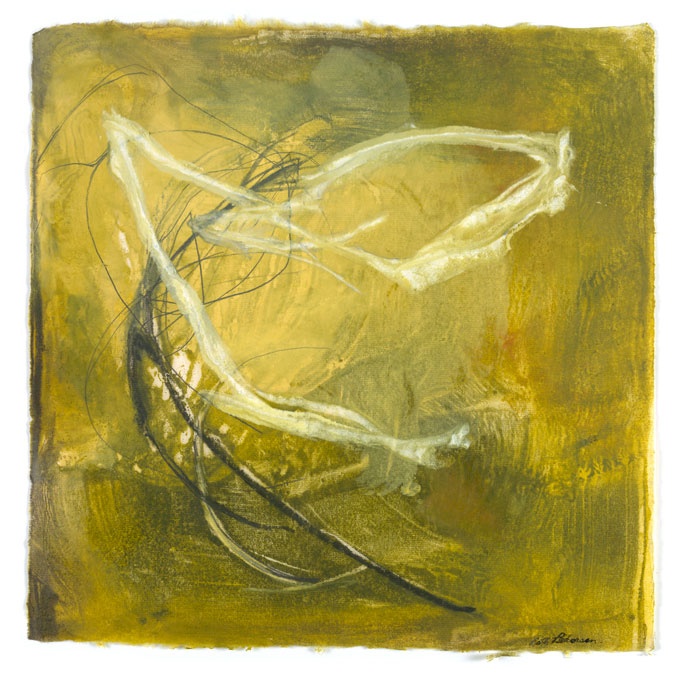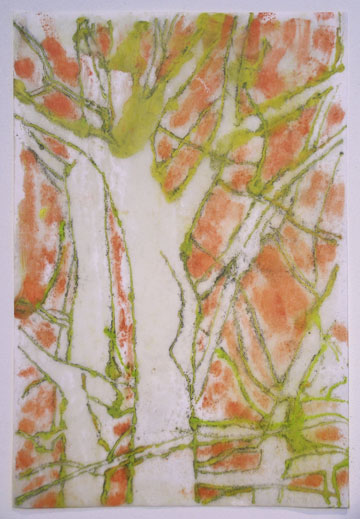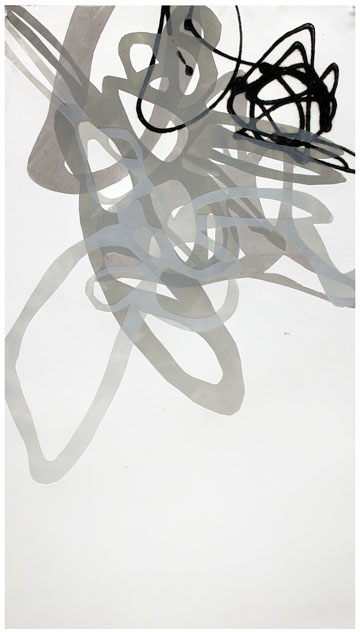Art Scene
by Jack Foran

Risky Beeswax
A current show of monotypes and monoprints at the Indigo gallery comprises works by three artists, Mark Lavatelli, Beth Pedersen, and Kathleen Sherin. Basically, one-of-a-kind works. Pedersen’s are all encaustic monotypes, that is, in wax and pigment. Lavatelli’s are mostly encaustic monotypes, with a few earlier production non-encaustics included for good measure. And Sherin’s are monoprints of various sorts.
In an artist’s statement, Pederson says of her work that it’s more about image-making than the images made. The others might say much the same about their work. Not that the images are not significant, or not beautiful. But when these artists talk about their art, they talk mostly about their involvement with their process/processes.
As in demo talks at the gallery the afternoon after the opening. They passed around materials including examples of their work at various stages. And little blocks of beeswax-cum-pigment that get melted down and applied in one of several ways to paper or some other backing to create the encaustics. “One of the reasons we do this,” Pedersen said, “is that the beeswax is so intoxicating.” Not literally. But literally toxic, as Lavatelli explained. He said he makes his own encaustic paints, that is, mixes the beeswax and pigment, “because they’re so expensive.” But he does it in a glove box he built for this purpose, that allows manipulating the materials in an enclosed space, preventing or minimizing the chance of breathing in toxic powders or fumes. (Encaustic materials in a solid or cooled state, when the pigments are captured within beeswax, are not toxic. Only some of the pigments “loose,” as it were, prior to capture in the beeswax.)

Pedersen and Lavatelli talked about different “hot box” apparatus they use in producing their encaustics, basically an anodized-aluminum-top surface heated by an array of light bulbs underneath (again, Lavatelli--a frugal man as well as resourceful—said he built his own).
Sherin talked about how she makes her monoprints—so employing a press—using various kinds of relief items including—particularly for the twine tangle signature figural elements in her current work—powdered carborundum suspended in a liquid acrylic that when it dries is inked, resulting in a dense black impression, depression, in the finished print. Collagraphic monoprints—akin to collages, but run through a press—are made with whatever sort of layering relief item or items, lace, leaves, fabric, stencils, paper, plastic.

Much talk also by all three artists about Japanese paper of various sorts, to achieve various visual and tactile effects.
As to imagery, Pedersen has works in three series, Earth, Sky, and Water. All pretty abstract. In the Sky series you see some stars or maybe shooting stars. In the Earth and Water series, more the colors of those elements than recognizable forms. Suggestions of flowers emerging from the mud. Suggestions of the constant movement of lake or ocean waters.
Lavatelli’s encaustics are nature depictions and more representational. Flowers in one series, trees in another. A quality of encaustic art in general is a kind of translucence, resulting in sometimes uncanny color and light effects. Some of the works of both encaustic artists give an impression almost of stained glass, as if lit from behind.
Sherin’s imagery is of rope or twine or yarn in knots and snarls, and contrasting orderly patterns, like schools of fish, or laminar arrays. Reflecting rationality somehow, from some source, some principle, versus the source or principle of disorder, turmoil. Works about the idea of contrast. Order and chaos, light and dark. A little bit Manichean.
But want to learn more about the processes? Hands on? In conjunction with the Indigo show, Lavatelli and Sherin are giving workshops on techniques of encaustic monotype and relief monoprints, respectively, at the Western New York Book Arts Center. Lavatelli’s is February 21 from 2 to 4:30pm. Participants will create encaustic works on paper on a surface of warmed anodized aluminum, and transfer them “effortlessly,” the slinger says, to Japanese paper. Sherin’s workshop is March 28 from 1 to 5pm. Participants will explore monoprint production using relief items and other textural elements and direct ink manipulation. Use of brushes, brayers, and plate wiping techniques to introduce painterly elements will also be explored, and variant printing procedures such as multiple press runs. The cost for the Lavatelli workshop is $50 (WNYBAC members $40) and for the Sherin workshop $55 (WNYBAC members $45).
The Indigo show is called Singular Impressions. It runs until March 1.
blog comments powered by Disqus|
Issue Navigation> Issue Index > v14n7 (Week of Thursday, February 19) > Art Scene This Week's Issue • Artvoice Daily • Artvoice TV • Events Calendar • Classifieds |









 Current Issue
Current Issue